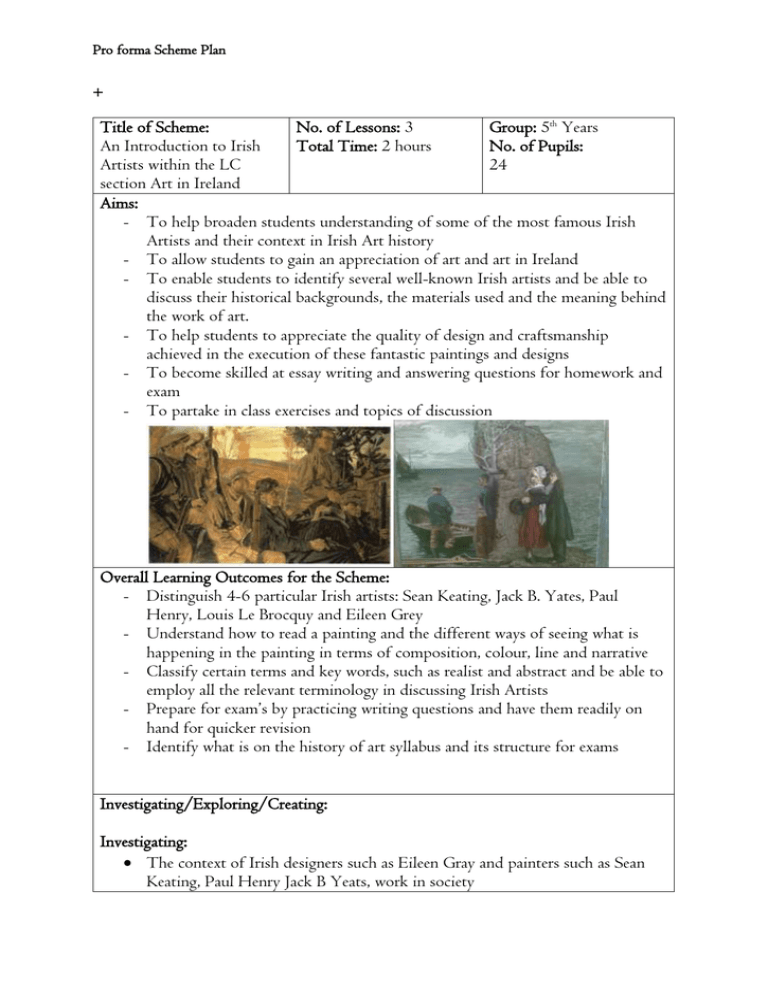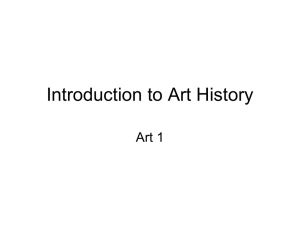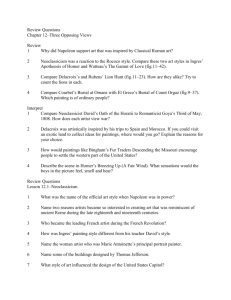File
advertisement

Pro forma Scheme Plan + Title of Scheme: No. of Lessons: 3 Group: 5th Years An Introduction to Irish Total Time: 2 hours No. of Pupils: Artists within the LC 24 section Art in Ireland Aims: - To help broaden students understanding of some of the most famous Irish Artists and their context in Irish Art history - To allow students to gain an appreciation of art and art in Ireland - To enable students to identify several well-known Irish artists and be able to discuss their historical backgrounds, the materials used and the meaning behind the work of art. - To help students to appreciate the quality of design and craftsmanship achieved in the execution of these fantastic paintings and designs - To become skilled at essay writing and answering questions for homework and exam - To partake in class exercises and topics of discussion Overall Learning Outcomes for the Scheme: - Distinguish 4-6 particular Irish artists: Sean Keating, Jack B. Yates, Paul Henry, Louis Le Brocquy and Eileen Grey - Understand how to read a painting and the different ways of seeing what is happening in the painting in terms of composition, colour, line and narrative - Classify certain terms and key words, such as realist and abstract and be able to employ all the relevant terminology in discussing Irish Artists - Prepare for exam’s by practicing writing questions and have them readily on hand for quicker revision - Identify what is on the history of art syllabus and its structure for exams Investigating/Exploring/Creating: Investigating: The context of Irish designers such as Eileen Gray and painters such as Sean Keating, Paul Henry Jack B Yeats, work in society Pro forma Scheme Plan How to read and explore a painting for example a realist painting such as ‘An Allegory’ How to describe modern architecture, decorative arts and stlylised furniture The historical background of the designers and painters under study Similar Irish Artists to the one you are studying, so that you will be able to compare and contrast The artistic movement when the object or painting was created and how it was represented during the time Exploring: The materials, techniques or mediums used in the design or painting The narrative of the painting The theme or mood of the painting The composition Contextual information The style, rhythm, subject matter or influences Creating: To be able to produce sketches of the painting or design in question To be able to answer the question with full competence To be become more confident and be able to participate in class discussion To be able to take notes during class and ask questions History of Art and Critical and Contextual Studies Knowledge: Discuss the historical background of Sean Keating, Jack B. Yeats, Paul Henry and Eileen Gray Specify facts, figures and dates in relation to the artist and the painting in question Refer to least two pieces of work for each artist for example Sean Keating’s Men of the West and An Allegory Compare and contrast two pieces of work Pro forma Scheme Plan Discuss the materials for example oil on canvas or gouache paint List techniques such as lacquer, broad brushwork and thick impasto Explain the narrative of the painting and what is really going on in the background Recognise symbolism and any hidden meaning or innuendo Understand the representation of colours and lines. Is the painting landscape, abstract or figurative? Is the piece of furniture modernist archirecture Skills: Participate in group discussion within the classroom Construct an essay answer for each question Illustrate the paintings under investigation and provide in your answers Compose valuable notes in the classroom in preparation for homework and exam revision Judge a piece of work and arguably explain your answer Complete work sheets and develop essay writing skills, answering, drawing/illustration techniques Attitude: Argue and form an opinion Critically evaluate the paintings, artists, designers work Understand key words such as lacquer, impasto, nationalist and naturalism Classify important imagery, symbolism and dates in relation to social and artistic movements Participate in questioning, answering and discussion in the classroom Justify and support your understanding of Irish artists and the importance in the Art appreciation section Pro forma Scheme Plan ICT: Power point presentation Videos Visual Images Interactive whiteboard Computers Printers Photocopiers Literacy and Numeracy: Abstract, Figurative, Realist, Mood, Narrative, Modern, Observation, compare, contrast, discuss, design, decorative arts, architectural modernism or modernist architecture, lacquer, interior design, cultural figures, art nouveau, nationalism, Teaching/Learning Strategies: Worksheets Notes and Handouts Student to take notes Questioning and Discussion (student /Teacher led?) Pacing the lesson and allowing time for a break during doubles Quizes Materials: Pencils, coloured pencils, biros, paper, images, worksheets, textbooks and copybooks Safety Precaution: N/A Differentiation: There will be a difference in the level of the homework produced and the feedback given in class, as some if the of the students will be doing higher or ordinary level Extra attention will be given to those in need. Where appropriate identify learning difficulties and the support needed. Highlight key words and phrases Use repetition of words Adjust the vocabulary and the pace of the lesson to suit the needs of the individual Pro forma Scheme Plan Highlight lesson objectives learning outcomes on the board Provide notes and visual aids when needed Re-illiterate and revise learning outcomes and objectives at the end of every lesson Employ a buddy system if needed Identify the learning outcomes to the students at every lesson Timeline/Sequence of Lessons: Week 1: I will begin the lesson with an introduction to Irish art and how it is presented for the LC paper. I will go through marking schemes and structures briefly. I will introduce the scheme through teaching how to observe a painting and how to answer a sample question. I will cover Sean Keating and Jack B Yeats this week. I explain the lesson with a PowerPoint presentation to make it visual and interesting and I will ask the students questions as I go along. I will then give out notes and handouts and we will practice answering questions in the classroom. Week 2: I will cover Eileen Gray and focus on her historical background as one of the most significant female designers and architects of our generation. I will discuss how her work was split into two parts: decorative arts and modernist furniture by her critics. I will refer pieces of her work and elaborate and discuss them with the class such ‘The Bibendum Chair’ which was one of the 2Oth Century’s most recognisable furniture designs. I will ask the class to analyse a piece of her work and we can discuss afterwards. I will give out notes and worksheets also. Week 3: In this final lesson of our scheme on Irish Artist, I will cover Paul Henry, a post-Impressionist painter, one of the Irelands best known artists ever produced. I will discuss his background. I will present on a PowerPoint and show images of his work such as ‘The Launching of the Curragh’, ‘The Lobster Fisher’ and ‘The Watcher’. I will ask the students to analyse the images in class and take notes. I will go over briefly what we have learned and I will then ask the students to recap everything by giving a 5 minute quiz. Pro forma Scheme Plan Assessment Rubric: 1 Drawing 2 Investigation Illustrate/ Sketch (at least two examples) for each question from each artist Eileen Gray, Paul Henry, Sean Keating and Jack B yeats Good practice of organisation and planning essay type answers in preparation for exams Include diagram and explanations beside them in your answers Applied appropriate illustrations to suit the question Use of colour in your sketch or diagram Include explanations beside your illustrations Ability to anaylse, look at or critique a piece of art Understanding the processes, mediums, materials used by these artists Develop a critical awareness of the aesthetic elements in modern design, art and architecture Investigate historical, social and cultural background behind the artists and their works 3 Problem Solving and making 4 Understanding and attitude Developing skills in the use of general questioning, looking and reading a painting or piece of design furniture Willingness to cooperate and work in groups and individually, therefore contributing to the fieldwork and workshop learning activities Ability to test technical and visual approaches within the overall framework of art appreciation Understanding of processes used, key words and terminology Practice of sufficient time management for answering the questions Study the social context or background of the work Willingness to overcome and persevere creative and observational challenges Effective co-operation in discussing the work in the classroom Evidence of being able to answer questions and having an understanding of Irish Art Evidence of Learning Showing an appreciation for Irish artists and an admiration for the aesthetic qualities of their work in your drawings, essays and in your answers in class Complete drawings, sketches or diagrams of the artist’s work in question in class and for home work Ability to take sufficient amount of notes in class for research for future homework questions Completion 4 questions covering the work of each artist per question in class and homework Evidence of looking at formal qualities like basic shapes, composition, colour, tone and line through classroom discussion and evidence in homework essays Explain the process used by these artists, modern and chronological artists and practices Become more skillful at looking and critiquing Have compared and contrasted different artists and their work in a single question Categorize different artists in terms of their work, social context and mediums Applied appropriate stage by stage planning, note taking, questioning for developing your knowledge Have at least 4 questions completed covering 4 different artists Have developed skills in terms of questioning and looking Have evidence of knowledge of the background of each artist and their work and studied the social context within the framework Careful planning and implementing the correct strategies and procedures for essay writing and questions Personally engaged with the process and all its facets in the full and integrated nature of the work, both creative and contextual Developed more confidence and gained clarity during the process throughout the different stages during classroom presentations and discussion







